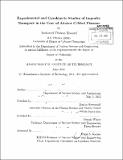| dc.contributor.advisor | Martin Greenwald. | en_US |
| dc.contributor.author | Howard, Nathaniel Thomas | en_US |
| dc.contributor.other | Massachusetts Institute of Technology. Dept. of Nuclear Science and Engineering. | en_US |
| dc.date.accessioned | 2013-02-14T15:17:37Z | |
| dc.date.available | 2013-02-14T15:17:37Z | |
| dc.date.copyright | 2012 | en_US |
| dc.date.issued | 2012 | en_US |
| dc.identifier.uri | http://hdl.handle.net/1721.1/76920 | |
| dc.description | Thesis (Ph. D.)--Massachusetts Institute of Technology, Dept. of Nuclear Science and Engineering, 2012. | en_US |
| dc.description | Cataloged from PDF version of thesis. | en_US |
| dc.description | Includes bibliographical references (p. 227-238). | en_US |
| dc.description.abstract | Using a unique set of diagnostics and modeling tools, a comprehensive study of impurity transport was performed on Alcator C-Mod L-mode discharges. A new, multi-pulse laser blow-off system was designed and constructed to introduce trace amounts of non-recycling, non-intrinsic, impurities in the plasma edge. This system was coupled with an x-ray crystal spectrometer, a single chord x-ray/ultraviolet spectrometer, and measurement of the laser blow-off neutral source at the plasma edge to provide full, time-evolving, radial profiles of a single impurity charge state. An iterative X2 minimization scheme was created to infer the experimental impurity transport coefficients and their uncertainty by minimizing the difference in the measured and STRAHL simulated emission. These measurements and data analysis methodology allowed for determination of impurity transport coefficient profiles with realistic errors from 0.0 </= r/a </= 0.6. The gyrokinetic co(le, GYRO, was use to analyze the same discharges. Motivated by linear stability analysis and a rigorous assessment of simulation sensitivities, nonlinear gyrokinetic simulations were performed such that small modifications of the Ion Temperature Gradient (ITG) drive term, a/LT, were made to match the simulated ion heat flux, Qj. to the experimental value. These simulations demonstrated simultaneous, quantitative agreement with experiment across the simulation domain in the ion heat and impurity particle transport channels, and indicated the possibility of missing electron dynamics from the nonlinear gyrokinetic simulation. A study of Ip scaling used four discharges, constituting a scan of I, from 0.6 to 1.2 MA. These discharges displayed a clear reduction of the experimental impurity diffusion and inward convection, allowing for qualitative and quantitative comparison of experimental with gyrokinetic simulation. Linear stability analysis and high fidelity, global (0.29 </= r/a </= 0.62), nonlinear GYRO simulation of ion scale turbulence (kop, </= 1.15) were performed on these discharges with the result that nonlinear gyrokinetic simulation was generally able to reproduce both quantitative values and trends for the measured decrease in impurity diffusion and inward convection observed experimentally. Initial analysis of three discharges operated at various levels of ICRH input power displayed a reduction of the experimental impurity diffusion coefficient with input power. An in-depth linear stability analysis suggests a transition of the turbulence character (ITG to TEM) with input power which may explain changes in the measured diffusion. | en_US |
| dc.description.statementofresponsibility | by Nathaniel Thomas Howard. | en_US |
| dc.format.extent | 238 p. | en_US |
| dc.language.iso | eng | en_US |
| dc.publisher | Massachusetts Institute of Technology | en_US |
| dc.rights | M.I.T. theses are protected by
copyright. They may be viewed from this source for any purpose, but
reproduction or distribution in any format is prohibited without written
permission. See provided URL for inquiries about permission. | en_US |
| dc.rights.uri | http://dspace.mit.edu/handle/1721.1/7582 | en_US |
| dc.subject | Nuclear Science and Engineering. | en_US |
| dc.title | Experimental and gyrokinetic studies of impurity transport in the core of Alcator C-Mod Plasmas | en_US |
| dc.type | Thesis | en_US |
| dc.description.degree | Ph.D. | en_US |
| dc.contributor.department | Massachusetts Institute of Technology. Department of Nuclear Science and Engineering | |
| dc.identifier.oclc | 824171847 | en_US |
